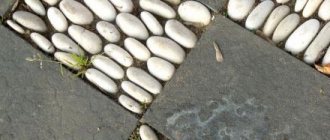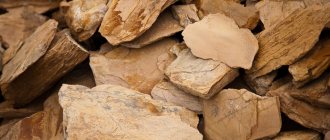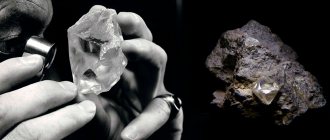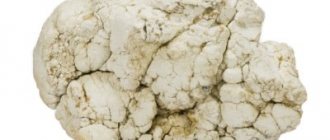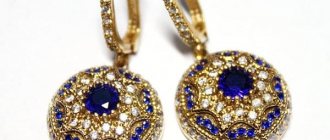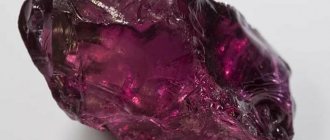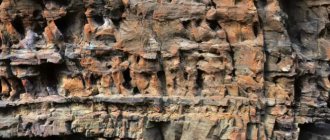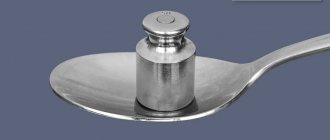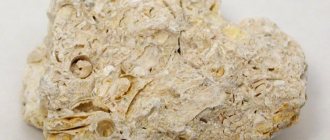Pebbles are a type of gravel, small round stones formed in nature by the action of water and wind. The natural process of pebble formation takes a period of tens to hundreds of years; the raw material is used as a construction finishing and decorative material. Modern production technologies make it possible to obtain pebbles of any size, color, shape; what type of material will be obtained at the end of the production cycle depends on the source raw materials.
Pebbles are made from granite, marble, gypsum, and various types of sandstone. Artificial stone is completely identical in appearance, color, and pattern to natural stone, but sometimes costs much less, since it does not need to be transported from distant regions and states.
Types of pebbles
Various types of pebbles are widely used for wall cladding, in interiors, and in garden plots. All of them have their advantages and disadvantages, which determines the scope of their application.
Marine
Sea pebbles are becoming increasingly popular and are used for building walls, paving paths, sidewalks, constructing fountains, and flower beds. In apartments and houses using sea pebbles, separate zones are often allocated on the walls; they are used for the floor in the bathroom, that is, the use of pebbles from the sea is not limited in any way.
Before use, it is recommended to rinse the sea pebbles thoroughly from water, since salt appears in spots on its surface after drying. Pebbles can be laid in different ways; for the floor, cement mortar is usually used; for the construction of walls, pebbles are attached with glue.
Photo of sea pebbles
Decorative
Decorative pebbles are made artificially from slate, gypsum, granite or marble chips. The softness of the raw materials allows you to obtain finishing materials of any shape, size; the color of decorative pebbles also varies. Artificial stone is used in a wide variety of design projects; it is used to decorate personal plots and make interior decoration of the house.
River
River pebbles mainly contain granite and quartz and are considered one of the durable natural materials. The sizes of river pebbles vary from a few millimeters to 20 cm. Natural material is found in large quantities in the foothills of Altai, the Urals, the Caucasus, and Karelia. River pebbles can be three-colored, white, black, gray; the combination of different shades allows you to bring to life the most daring ideas of landscape designers.
In the video, river pebbles of fraction 6-8 mm:
White
White pebbles can be either round or oblong. The color varies from boiling white to grayish. Mostly natural white pebbles are collected in the foothills of the Caucasus, in the openings of mountain rivers. The range of applications is not limited; white color is suitable for decorating paths, swimming pools, and store windows.
Marble
Marble pebbles are produced by crushing marble; waste from products is widely used in its production. The split marble is polished and polished, resulting in a stone that does not have sharp corners.
Marble pebbles can be not only white; gray types of pebbles are widely represented on the market; brown and pinkish shades are popular. The main area of use is landscape design; small stones are often used to decorate walls, porch steps, and recreation areas.
Photo of marble pebbles
Small and large
Small pebbles can be either river or sea. Its color varies from dark gray to different shades of white. There is a natural stone of reddish and green shades. Small-sized pebbles are successfully used both for decorating different areas of a personal plot and for producing various crafts. Large pebbles are most often used in finishing floors, paths and pools.
Granite
Granite pebbles are made from natural granite, which is composed of small grains of quartz, mica and feldspar. The special granular structure of the stone increases its strength characteristics and resistance to low temperatures. Granite is well processed and therefore pebbles from it are round in shape and of a wide variety of sizes. Granite is mined in quarries in Siberia, the Urals, and the Caucasus.
Photo of granite pebbles
What granite pebbles look like
Products made from granite pebbles
Caspian
Caspian pebbles are collected by hand and have a low specific gravity, which makes it possible to use different methods for laying them. The color of Caspian pebbles is predominantly sandy; brownish or light varieties of stone are also found. Caspian pebbles are formed from sedimentary rocks and therefore have a flat shape.
Photo of Caspian pebbles
Colored
Colored pebbles produced artificially are painted with decorative paint. Such pebbles can be washed, they do not fade in the sun and their surface does not deteriorate due to temperature changes. You can choose any color of pebbles, which allows you to fully comply with the main style of your personal plot or, on the contrary, highlight individual elements.
Silicon
Flint pebbles have a specific scope of application; they are purchased mainly for filtering water in reservoirs and wells. Silicon is a natural material; it successfully absorbs petroleum products and phenols from water. Silicon frees water from microbes and pathogenic bacteria, clarifies it and improves its taste.
Photo of silicon pebbles
Glass
Glass pebbles are made from leftover glass. The addition of paints and different production technologies make it possible to obtain rounded stones of a wide variety of shades and patterns. Glass pebbles look very elegant; they are used to decorate bathroom walls, mirror frames, and make crafts and decorations. Despite the fact that glass is a fairly fragile material, pebbles made from it are highly durable and can withstand great pressure.
Photo of glass pebbles
Beach with glass pebbles
What glass pebbles look like
Black
Black polished pebbles are made from durable rocks - marble or dolomite. Polishing takes place in special drums, where the stones are subsequently coated with a composition to impart gloss. The shiny gloss is well preserved during transportation, does not deteriorate from frost and humidity, and when chipped, this type of pebble has the same black color as its outer surface.
Photo of black polished pebbles
On a substrate
Pebbles on a backing or mesh are made by attaching natural small stones to a base. A nylon mesh is used as a base; the main advantage of this type of pebbles is ease of installation. Pebbles on a substrate bend well, can take on curved and wave-like shapes, and when installed, the operating time is reduced several times. Pebbles on a mesh can also be used independently as a foot massage mat.
Washed
Washed pebbles are freed from impurities of sand and bottom silt, and sea stones are freed from salts. Clean material is much more convenient to use, its color is immediately visible, and all adhesives firmly grasp the washed pebbles together.
How to make a painting or craft from sea stones with your own hands: photo and description of the process
Sea stones are a unique natural material originating from prehistoric times. They are fragments of rocks (granite, basalt, sandstone, shell rock), which, thanks to centuries-old grinding by sea waves, have taken on a rounded shape. Even semi-precious and precious stones wash up on the seashore. Any of them is a godsend for a creative person: they are used to make paintings, drawings and crafts that can decorate the interior of a home, office space or garden. How to turn pebbles into something beautiful and unusual? What crafts can you make from this natural material with your own hands?
Technical characteristics and density of pebbles
Natural pebbles have several main characteristics, which vary depending on the base material:
- The density of pebbles varies from 2550 to 2670 kg/m3. The area of application of pebbles depends on the density, that is, specific gravity; heavy rocks are mainly used for paving paths, light rocks can be used for cladding walls.
- The weight of the pebbles depends on its size. Pebbles are usually sold in bags starting from 500 kg. The volumetric weight of pebbles is approximately 1650 kg. Knowing the weight of the pebbles and the area of the area to be decorated, you can approximately calculate how much material you will need to buy.
- The sizes of natural pebbles used as finishing material start from 5 mm and end at 40 cm.
- The service life of pebbles is unlimited. The strength of paths and cladding mainly depends on compliance with laying technology; natural stone can withstand all weather conditions well and is inert in relation to other building materials.
- The environmental friendliness of pebbles is beyond doubt. Both natural and artificial pebbles consist only of natural raw materials; they do not emit harmful substances even when heated.
- The hygroscopicity of pebbles depends on the base type of stone. Basically, pebbles do not allow water to enter, dry quickly and protect the walls of the house from high humidity.
Decorating with pebbles has always been very popular. It can be used not only in interiors with a marine style. Pebbles will fit well in the kitchen (work area), bathroom (floor, walls or pebble rug) and other rooms (wall inserts, arches, columns).
Original panels. Part 1. From sea pebbles.
Greetings, my dears! I want to share with you an interesting find, interesting panels made of sea pebbles! Amazing ideas for interiors! And as always, everything ingenious is simple! See for yourself
These are such wonderful panels! I saw enough beauty... I was inspired)... Somewhere in my dacha there are sea pebbles that I brought). They'll come in handy! I knew this.
I would be grateful if you liked the material). Photos were found on the Internet. Good weekend!
Yamogu: Handmade so far, I want a sewing machine.
How to create a picture from stones
First of all, you need to prepare everything for work, you will need:
- stones of different colors and shapes;
- glue (you can take the usual “Moment” - it glues any materials);
- a sheet of thick cardboard, plywood, a board or a cut of wood about 5 cm thick;
- oil paints or gouache - due to the fact that the surface of the stone has micropores, it will adhere well.
Picture of stones “Tree”
To make it easier to assemble a picture of stones, the surface of the prepared material can be painted in a light tone, draw a sketch of the future image on it with a simple pencil or black marker, and then select pebbles that are suitable in shape and color to fill the contours. You can glue the stones by squeezing droplets of glue directly from the tube, but it is more convenient to use a glue gun.
What to make from stones for the first time - you can use a very simple picture, assembled from just a few pieces, for example, a figurine of a person or a dog: select stones suitable for the head, torso, arms, legs or tail and paws - the first hand-made work is ready. But the charm and richness of such “laconic” grace will most likely be appreciated by an adult, and together with children it is better to do something bright. For example, “draw” a childhood memory of a trip to the sea, from which stones were brought as a souvenir of the vacation.
Painting made of stones “Memory of the Sea”
Examples of ready-made crafts
Ready-made stone crafts simply captivate with their unusualness and beauty; they can come in the most unexpected variations, not only as decoration for the home, but also as a “stone rug” for the floor - just look at the photo to repeat:
Handcrafted products from sea stones will be an excellent decoration for the interior of a room, and are perfect for an unusual, exclusive gift for a loved one. And the kids, having made a “stone masterpiece” on their own, will be very happy to use it in their games. Stone products are timeless, so they will delight their owners for decades.
Lots of ideas on what to make from pebbles: beautiful crafts from sea pebbles
You can make wonderful crafts from natural stones of different sizes; they will not only be spectacular, bright and original, but also durable. A large number of all kinds of pebbles can be picked up on the seashore or river. Material for creativity is not expensive at all. We offer you information on creating crafts from sea stones - video materials, ideas, options and methods of assembly, rules for preparing the material, as well as ready-made works for decorating the interiors of rooms, premises, terraces or gazebos.
Let's draw the sea
In addition to stones, a base for the painting, glue and gouache, you will need a small amount of wool thread.
First, the sea pebbles must be washed and then dried thoroughly. Then apply a sketch of the drawing to the base under the picture - it’s easier for a small child to do this with a marker or felt-tip pen. Draw the outlines of a tree on the beach, the sea, a boat, a man in it, and in the corner draw the outlines of the sun.
The next step is to select the appropriate shaped pebbles. If they are bright, they don’t need to be painted; for example, a brown stone doesn’t need to be touched at all - it will make a trunk for a tree of natural color.
Paint the stones for foliage green, for the sun disk yellow, draw eyes, a nose, a mouth on the face stone, and paint the one that will become a shirt or dress with a checkered pattern or a multi-colored ornament.
For a figurine of a man, stones need to be selected only up to the waist - he will sit in the boat.
While the painted stones are drying, there is time to work on the man’s hair: wind a woolen thread around two fingers, carefully remove the resulting ring, tie it in the middle with the same thread - if there is a boy in the boat, this will be a parting, for a girl - you will get two braids. Glue the resulting hair to the face stone.
Now that everything is ready, you can move on to assembling the picture.
Picture made of stones “Let’s draw the sea”
Make a frame from small pebbles, gluing it around the perimeter of the base. Paint the sea blue and the sky blue. To make it more interesting and more voluminous, make the sand from millet - the grain sticks well to cardboard and plywood; for this, the sand field is smeared with glue, scattered, lightly pressing it onto the lubricated surface. Draw clouds in the sky. You can also draw a boat, but it’s better to glue a piece of fabric or polyethylene, securing it along the edges, and leaving the middle slightly sagging - then the body of the man will really be in the boat. There is a lot of room for imagination - you can attach a sail made of silk or a piece of tarpaulin to the boat, and the boat itself can be made from tree bark or wood chips - the picture will look like a frame from a cartoon come to life.
Having seated the figurine in the boat, we move on to the tree, the trunk of which can also be made from real bark. To make it even more realistic, plant grass near the tree - press a bunch of dry grass at the base of the trunk with a pebble coated with glue. To ensure reliable gluing, hold for several minutes under a press, for example, a book.
In the process of collecting a picture, everyone can come up with their own ideas. A scattering of very small white pebbles will make excellent wave crests.
You can also paint a smiling face on the sun, but let it be just yellow - it will look more like a real beach. The painting is created from natural materials; its value lies in its closeness to nature; excessive cartoonishness is of no use here.
Pictures made of stones
Together with your child, you can make amazingly beautiful pictures from stones - pebbles come in different shapes, the palette of natural shades is so rich that they turn out to be truly alive. It is pleasant to hold sea stones in your hands - they quickly warm up from the warmth of human hands; if the child is too active, the activity will calm him down and teach him to focus his attention. How to make these masterpieces is not at all difficult, and also not expensive, because nature itself gives everything that is required to create a picture from sea stones.
Making crafts with your own hands from various materials using different techniques is a fascinating, educational activity; adults spend their leisure time doing homework. For children, this is an opportunity to develop imagination, fine motor skills of the fingers, and in the process of work, gain useful information about how the world works, learn interesting facts and details about the life of animals and plants. Drawing with colored pencils, watercolors, modeling from plasticine, clay, embroidery floss, origami, making figurines from pine cones, compiling herbariums - over time, all these familiar materials for crafts can get a little boring for children, in order to get them interested again - you have to look for new activities.
Applications and paintings on cardboard and paper using glue and plasticine
To connect small stones together when creating applications and paintings, not only glue, but also plasticine is often used. Various elements are made from it - animal body parts, leaves, stems, trunks. The material is absolutely safe; children of any age can work with it. Polymer clay is sometimes used instead.
To create an applique, take a colored piece of paper or a white one, which should be painted. First you need to come up with a plot for the picture, decide what will be depicted and how it will be positioned (see video). After this, pebbles of suitable shape and size are selected and painted in the desired color with acrylic paint. The plasticine is kneaded by hand and the necessary elements are molded from it. Then you need to assemble the applique: painted pebbles are glued to the sheet in the right places, and plasticine blanks are attached to it. The finished application can be coated with acrylic varnish and inserted into a frame.
If you take one round pebble, sculpt a head, 4 paws and a tail out of polymer and fasten it together, you get a turtle. Various animals, fish, and birds are created in this way. The resulting figure can be glued with glue onto a paper or cardboard sheet to get a picture.
Preparing for work: where to find suitable stones and what else will you need?
Many people, when at sea, love to collect colorful pebbles and bring them home as a memory of their vacation. These pebbles are good for crafts. If necessary, stones can be purchased. This will not entail large financial costs, because only a small amount is needed. Stores offer material of any color and size, with a smooth or rough surface, with inclusions and veins. Natural stones are also available in pet stores that sell everything for aquariums.
To make crafts from stones you will need other materials:
- glue (“Moment”, PVA);
- paints (acrylic, gouache) and brush;
- polymer clay;
- varnish (acrylic, for nails);
- plywood.
A variety of crafts are made using other materials - beads, beads, shells, sand, glass shards, branches, scraps of fabric or leather. To work you will need brushes and a pencil. In order to protect the workplace, it should be covered with oilcloth or newspapers. A robe or apron will help protect your clothes. You can just wear something that you don’t mind getting dirty.
Before work, stones from the seashore must be cleaned of sand, washed and rinsed with boiling water. If river ones are used, they need to be boiled for 10 minutes and dried. This gets rid of microflora, due to which the stones may later become covered with algae or mold.
